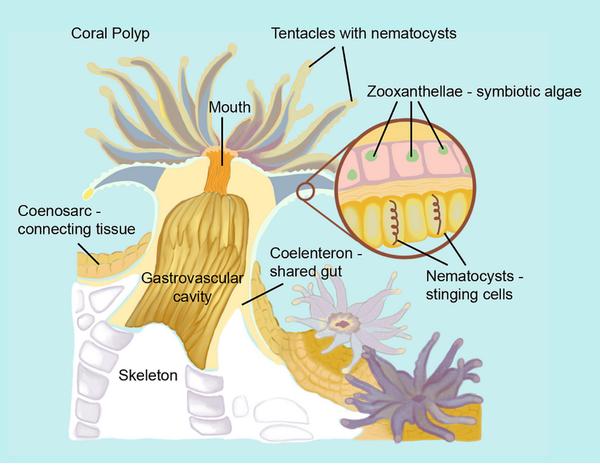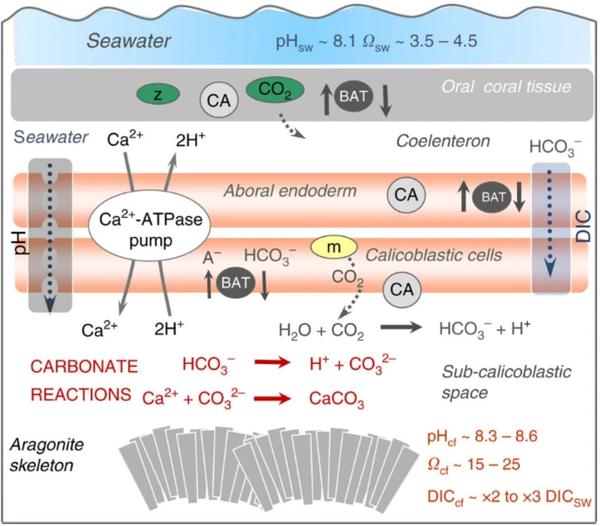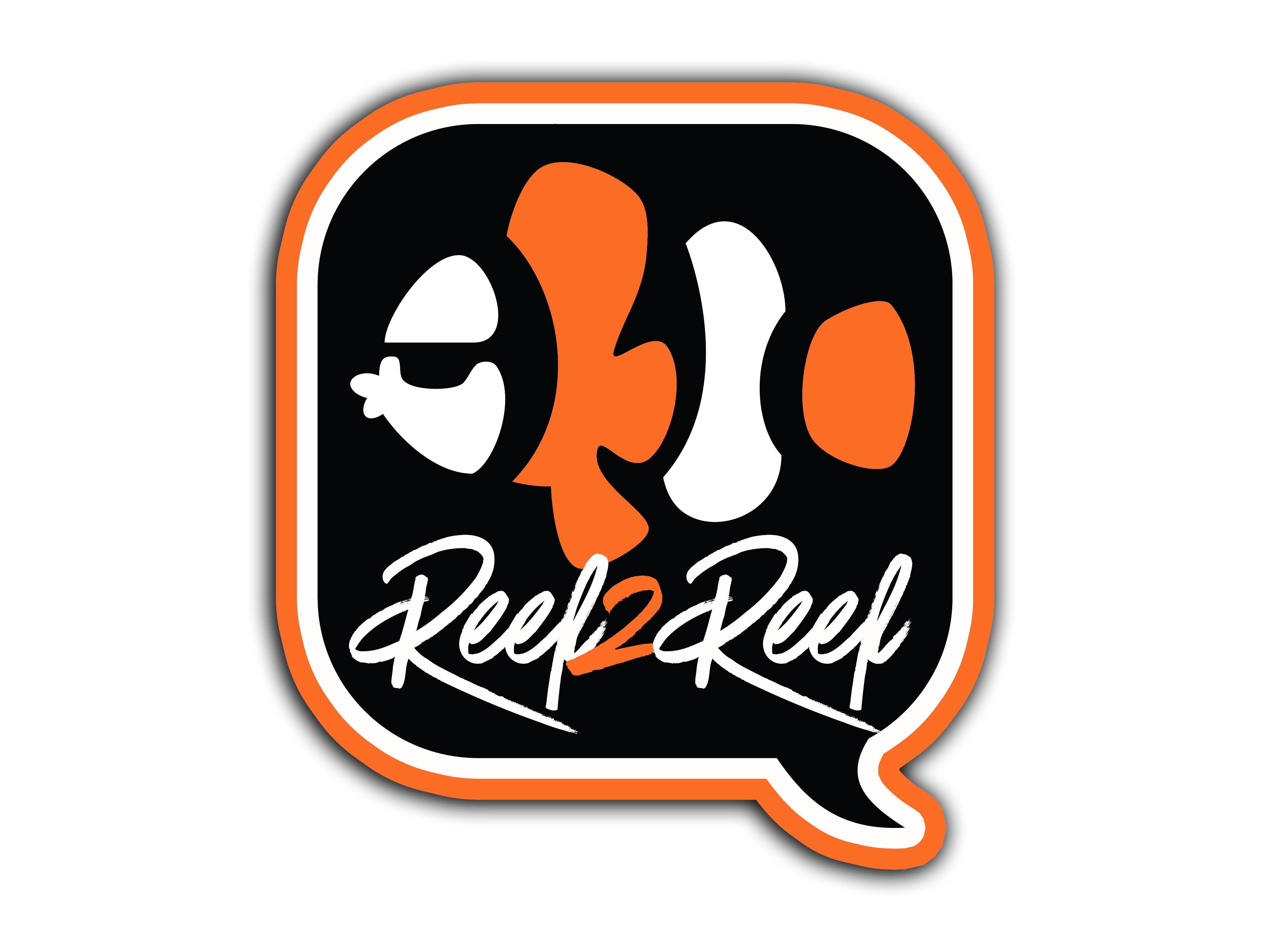Introduction
The process of calcification or biomineralization in SPS corals is often a head scratcher for most people, let alone reefing hobbyists. I've always wondered myself what really goes on behind the scene. Through research, I reviewed some research papers in order to help us better understand how our husbandry and maintenance of our aquariums can affect the growth of our corals. I have shared my learnings below and broken everything down into ways that is easy to digest.To start with the basics, our SPS corals consist of three main parts: the skeleton, the polyps, and the zooxanthellae. Each plays their own role in constructing and maintaining the coral that most of us house in our aquariums.
The skeleton of the coral is the easiest to understand, it provides the structural support and housing for the polyps and zooxanthellae. The simple explanation is that the coral polyps and the zooxanthellae have a symbiotic relationship. The coral polyps provide protection and resources such as carbon dioxide and water that is created as a byproduct of cellular respiration to the zooxanthellae. In exchange, the zooxanthellae inhabit the safe and resource rich environment to undergo photosynthesis, consuming water and carbon dioxide to produce energy for the coral polyp. Other nutrients such as nitrogen and phosphorus can be obtained by either organism through other mechanisms such as heterotrophy.
Stony Coral Biology and Anatomy
Before we go into the process of calcification, understanding the biology and anatomy of the coral polyp as well as some basic chemistry properties can give better insight to how the process occurs.Polyps
When we talk about polyps, we are often talking about the visible tentacles that we can see. We are also able to see the mouth of the polyp and on some rare occasions, we may even be able to see inside the mouth into the gastric cavity.Coenosarc
Surrounding each polyp we have the coenosarc. This is the layer of skin that covers the bony skeleton and connects the entire coral into a single colony. It is in this area where the zooxanthellae are often housed.Coelenteron
Below the coenosarc, there is a layer of oral tissues and aboral tissues. Between the oral and aboral tissues, the coelenteron exists; this is the layer that acts like a stomach that is linked between nearby polyps. Under the aboral tissues, there is the calcifying fluid that separates the coenosarc from the bony skeleton.In simplification, the coenosarc is a layer that connects all the polyps and houses the zooxanthellae. In the coenosarc, seawater is kept out of the coelenteron (connected stomach) by the oral layer of tissue. The aboral layer of tissue is underneath and exists to keep the coelenteron and bony skeleton apart as well as help facilitate calcification of the bony skeleton.

Coral Anatomy. Taken from “Coral Bleaching” by Pappas M. (2020).
Skeleton
Now that we know what is above the skeleton, what exactly is the skeleton of a coral? If you’ve ever fragged stony corals, you know that the skeleton of corals can be really dense and hard to the point where you may need a bandsaw to make the cut. This skeleton is made of aragonite, which is actually mostly calcium carbonate; the same material found in egg shells and limestone. The difference between calcium carbonate in an egg shell and calcium carbonate in aragonite is the molecular structure, orientation, and other trace molecules. Similar to how coal and diamonds both are made up of carbon, however one is brittle to the touch and the other is the toughest material on earth.Chemistry
In order for minerals to exist in a stable state, their charge must be neutral. The chemical formula for carbonate is CO3-2. The calcium ion is found with a +2 charge, and is written Ca+2. The +2 charge from the calcium ion can bind to the -2 charge from the carbonate ion forming CaCO3, otherwise known as calcium carbonate. However carbonate exists in a constant tug of war called an equilibrium, existing in other forms aside from CO3-2 that our corals need for their skeletons, such as HCO3- (bicarbonate) as well as H2CO3 (carbonic acid). Note that H2CO3 (Essentially formed by interaction between CO2, carbon dioxide, and H2O, water) has a neutral charge just as calcium carbonate and is considered a stable state.pH
In a brief explanation, pH is the concentration of hydrogen ions, also known as the acidity of the water. Water has a pH of 7, this is neutral. If the pH is below 7, it is considered acidic, containing more hydrogen ions (H+). If the pH is above 7, it is known as more alkaline or basic, with more hydroxide ions (OH-). pH is important because it determines the bioavailability of nutrients in their usable forms, as well as influencing the form of certain molecules and minerals.If the pH is low, and H+ ions are readily available, CO3-2 has a much easier time becoming neutral by binding to H+ ions. When the pH rises and H+ ions are less readily available, CO3-2 becomes the main form that carbonate will be found in. If you look up a carbonate equilibrium chart online, you may notice that in order for carbonate to exist in the CO3-2 form, the pH must be at least 8.0 for even a small amount of CO3-2 to exist. At the pH of around 8.4, H2CO3 begins to form less and concentration of CO3-2 begins to go up, this means for our calcium carbonate skeleton to reliably form we require a pH higher than 8.4, but a pH of 8.4 may have a negative impact on the bioavailability of nutrients as well as the survivability of the coral. Just as our bodies are evolved to have a pH of 7.35-7.45, our enzymes and other proteins function best at that pH. Any dramatic changes to the pH can result in decreased functionality or complete loss of function of the enzymes.
Saturation and Solubility
The second concept that we should get a grasp on is the mechanisms of saturation and solubility. In layman’s terms, solubility is how easily one substance can be dissolved in another substance and saturation is the extent of how much one substance is dissolved into another substance. We can use sugar and water to demonstrate these concepts. When sugar is added to water and mixed, the sugar tends to melt into the water leaving no residue; this is solubility, the sugar is soluble in water and dissolves. When too much sugar is added; your mixture of sugar and water becomes fully saturated. When the water is fully saturated with sugar, any extra sugar you add will no longer dissolve into the water and you will see sugar at the bottom of the cup. You can often see this when you add too much sugar to your coffee or hot chocolate and as you’re finishing your drink you will see the granules of sugar slowly shift towards the edge of the cup. Saturation and solubility can be altered and changed based on other factors such as temperature and pH. This is why when you heat a cup of water that is fully saturated with sugar, you can get more sugar to dissolve into the water.Chemistry and Mechanism of Coral Calcification

Mechanisms involved in coral calcification. Image taken from “Coral calcification in a changing World and the interactive dynamics of pH and DIC upregulation” by McCulloch M.T., D’Olivo J.P., Falter J., Holcomb M., and Trotter JA. (2017)
To sum it up, a coral’s skeleton is made up of mostly calcium carbonate (CaCO3). CaCO3 is made from Ca+2 ions and CO3-2, which are dissolved in the water. Ca+2 can only bind with CO3-2 because of the +2 charge on the calcium ion and the -2 charge on the CO3 ion. CO3-2 can exist in 3 forms (H2CO3, HCO3-, and CO3-2) depending on the pH, and will begin to exist in higher concentrations when the pH rises slightly over 8.2. As pH increases, the solubility of CaCO3 in water decreases (Hart, P.W. et. al. 2011), This means that as the pH increases, the amount of CaCO3 that can remain dissolved in the water decreases. As a result, if the pH is high and the concentration of CaCO3 is high enough, it will cause the CaCO3 to precipitate out of the water and back into a solid form. This is the basis of how corals build their skeleton.
To start off, calcification occurs in the sub-calicoblastic space (McCulloch, M.T., et al 2017). This is the space that exists under the aboral layer of tissue below the coelenteron (linked stomach). The layers of tissue in between have pumps that can transfer the ions needed for calcification across from the stomach of the coral into the space between the tissue and the skeleton. In order to simplify the pathway we will be following each of the components individually.
Ca+2 :
- Ca+2 is absorbed into the stomach cavity from food or in the water
- A pump that exists in the aboral layer called the Ca+2-ATPase pushes the Ca+2 ion from the stomach into the sub-calicoblastic space in exchange for 2 hydrogen ions (H+)
- This causes the pH to decrease in the stomach where the H+ ions are pumped into and the pH to increase in the sub-calicoblastic layer where the H+ ions are pumped out from.
- Ca+2 reacts with free CO3-2 in the sub-calicoblastic space to form CaCO3
CO3-2 :
- CO3-2 can enter the cycle from two sources
- CO2 from the environment
- Dissolved into sea water by the atmosphere
- Breathed out from other organisms that use cellular respiration
- Fishes
- Ocean life
- Zooxanthellae
- CO2 from the environment
- CO2 is absorbed into the coelenteron along with ingestion of food or as a byproduct of cellular respiration.
- With the help of low pH in the coelenteron caused by the H+ ions pumped into it from the Ca+2-ATPase and some enzymes, the CO2 is converted to H2CO3 and HCO3-
- HCO3- enters the sub-calicoblastic space
- By diffusion
- HCO3- naturally passes the aboral layer and flows into the sub-calicoblastic space
- By active transport
- Proteins carry HCO3- across the layer with the help of energy or a carrier
- By metabolic reaction
- CO2 emitted by the calicoblastic cells as a byproduct of cellular respiration is emitted into the sub-calicoblastic space
- CO2 reacts with H2O in a high pH environment to form HCO3- and H+
- By diffusion
- HCO3- is in an environment with high pH and shifts into the CO3-2 form
- CO3-2 reacts with Ca+2 ions in the sub-calicoblastic space to form CaCO3
CaCO3 has multiple forms as we touched on earlier, it can be as fragile as an eggshell or as sturdy as a coral base. The form of CaCO3 that is created is called amorphous calcium carbonate (ACC) which is the least stable form. To combat this and make ACC more stable, the coral produces organic matrix molecules that aid in stabilization and is deposited together to form aragonite.
Factors that can influence calcification
Anyone who has tried to keep SPS corals can all agree that there are many factors that can influence the growth rate. This section will briefly explain how different factors can influence the rate of calcification.| Light |
|
| Inorganic Nutrients |
|
| Environment |
|
| Food |
|
| Genetics |
|
By having everything broken down it provides a deeper understand about how our actions may impact our corals. It is always better to understand why we do the things we do, instead of just doing it for the sake of doing. I hope this article has served as an interesting read as much as the research had been for me. Thank you for reading.
Resources Cited
- Falini G., Fermani S., and Goffredo S. "Coral biomineralization: A focus on intra-skeletal organic matrix and calcification." Seminars in Cell & Developmental Biology,Volume 46,2015,Pages 17-26,ISSN 1084-9521, https://doi.org/10.1016/j.semcdb.2015.09.005
- Giuffre A.J., Gagnon A.C., De Yoreo J.J., and Dove P.M. “Isotopic tracer evidence for the amorphous calcium carbonate to calcite transformation by dissolution–reprecipitation.” Geochimica et Cosmochimica Acta, Volume 165, 2015, Pages 407-417, ISSN 0016-7037, https://doi.org/10.1016/j.gca.2015.06.002
- Grottoli A.G., Dalcin Martins P., Wilkins M.J., Johnston M.D., Warner M.E., Cai W.J., Melman T.F., Hoadley K.D., Pettay D.T., Levas S., and Schoepf V. “Coral physiology and microbiome dynamics under combined warming and ocean acidification.” PloS one, 13(1), 2018; e0191156. https://doi.org/10.1371/journal.pone.0191156
- Hart P., Colson G., and Burris J. “Application of Carbon Dioxide to reduce water side lime scale in heat exchanges.” J. of Science and Technology for Forest Products and Processes. 1. 67-70 (2012).
- McCulloch M., D’Olivo J., Falter J., Holcomb M., and Trotter J.A. ”Coral calcification in a changing World and the interactive dynamics of pH and DIC upregulation.” Nat Commun 8, 15686 (2017). https://doi.org/10.1038/ncomms15686
- NOAA. “Zooxanthellae… What’s that?”. National Ocean Service website, Accessed 16, Jul 2021. https://oceanservice.noaa.gov/education/tutorial_corals/coral02_zooxanthellae.html
- Osinga R., Schutter M., Griffioen B., Wijffels R.H., Verreth J.A., Shafir S., Henard S., Taruffi M., Gili C., and Lavorano S. “The biology and economics of coral growth.” Marine biotechnology (New York, N.Y.), 13(4), 658–671 (2011). https://doi.org/10.1007/s10126-011-9382-7
- Pappas M. “Coral Bleaching.” Emerging Creatives of Science, (19 Oct. 2020) Accessed on 18 Jul 2021. https://www.emergingcreativesofscience.com/post/coral-bleaching
- Schutter M., Van der Ven R., Janse M., Verreth J., Wijffels R., and Osinga R. “Light intensity, photoperiod duration, daily light flux and coral growth of Galaxea fascicularis in an aquarium setting: A matter of photons?” Journal of the Marine Biological Association of the United Kingdom, 92(4), 703-712 (2012). https://doi.org/10.1017/S0025315411000920
- Venn A.A., Tambutté E., Caminiti-Segonds N., Teacher N., Allemand D., and Tambutté S. “Effects of light and darkness on pH regulation in three coral species exposed to seawater acidification.” Sci Rep 9, 2201 (2019). https://doi.org/10.1038/s41598-018-38168-0
- Veron J.E.N., Stafford-Smith M.G., Turak E., and DeVantier L.M. “Corals of the World.” (2016) Accessed 16 Jul 2021. http://www.coralsoftheworld.org/page/structure-and-growth/
- Wang X., Zoccola D., Liew Y.J., Tambutte E., Cui G., Allemand D., Tambutte S., and Aranda M., “The Evolution of Calcification in Reef-Building Corals” Molecular Biology and Evolution, 2021; msab103, https://doi.org/10.1093/molbev/msab103












